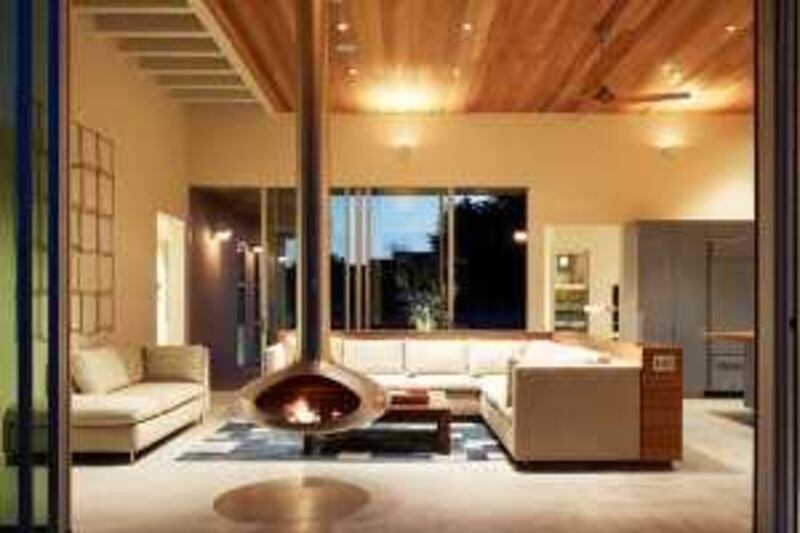Masdar's green city is soon to rise from the sands of Abu Dhabi. Green buildings are being designed and created across the UAE. And a rapidly increasing number of private and commercial homes around the world are going off-grid. More and more blueprints show this could be the dawning of a new sustainable age in architecture and design.
It is perfectly conceivable for citizens and residents in the UAE to be living in zero-carbon homes in the next decade. The homes do not have to be tower block apartments - they could be sublime beach houses with broad ocean views, such as one recently designed for a family in the small gated community of Seadrift in northern California. The 1,900-sq-ft house, designed by the San Francisco-based architect Cass Calder Smith, is a weekend retreat for three generations of a local family.
Sustainability was a must, so Smith set a goal to create a fully electric house, to be run entirely on renewable energy. He calculated the power the family and their guests would need over a given period and fitted photovoltaic panels to the roof. The panels generate all the home's electricity and even create a surplus that the family can send back to the local power grid, thereby reducing their power bills to zero.
"I've never done an all-electric house before so this is the first," says Smith. "Initially we thought that the concept didn't make sense and that we would need to have natural gas, but because the family is not there all the time, the energy demand is manageable. "It is an example of absolutely clean energy production. All the home's systems, such as the hot water, the heating and air conditioning, and the radiant heating are all integrated, electricity-based, and powered by the photovoltaic panels on the roof.
"There's a propane tank which powers the cooking range, but apart from that the home is net-zero carbon in terms of its energy consumption." Smith has allowed aesthetics to play as important a role as sustainability, making the house quite liveable. Skylights allow the California light to flood in, warming the native cedar ceilings and concrete floors. Two raised decks reach out from the north and side elevations of the house, allowing broad water views from the former and sun-drenched afternoons on the latter. The northern deck is multi-layered, allowing users to step down to the shoreline.
Smith is a modernist, which is perhaps surprising for someone who grew up in a highly communal environment. Hence his Seadrift creation is, while not minimalist, an uncluttered open-plan affair using materials such as aluminium for window frames and concrete for the floors. While he admits that it is virtually impossible to create any structure without impacting the environment in some way, he says architecture and design as a discipline is making great strides.
"It really wouldn't be hard today to design and build a totally sustainable house, using all reclaimed or recycled products and using vastly reduced energy and water supplies. I am sure there are some already built today," he says. "We have designed some buildings which used a lot of reclaimed wood and we are doing houses made from rammed earth. "My definition of a sustainable building is one that, once built, generates its own energy needs, and therefore has a carbon footprint of zero. A house that uses zero energy from any source - I would call that a truly sustainable building. Once it is up and running it is not dependent on any fuel." And there's no shortage of demand from homemakers.
"The interest in sustainable homes is running ahead of people's ability to afford them. Everybody is interested in them right now and that interest is only going to grow." But would such a structure as Smith's sustainable Seadrift house in temperate, maritime northern California work in the UAE? "No reason why not," Smith says, "as long as you get the cooling right. There must be virtually endless solar energy capability there, so a thoroughly energy-efficient and sustainable beach house on the shore near Abu Dhabi or Dubai is feasible with the use of photovoltaic solar panels to generate the electrical needs, which would be mostly for cooling.
"If it was my project, I would research indigenous architecture and design for vernacular examples of passive cooling strategies. I like to do this whenever possible. Once you look into it there's almost always some type of passive strategies to deploy such as using natural ventilation, for example." "There are bound to be some very practical ideas that local people have thought up and possibly developed many years ago to keep themselves cool in summer and warm in winter."
Back in northern California, keeping warm in winter at Seadrift is fun. The signature supplemental heating element is perhaps the most dramatic aspect of the house: the fire orb, which is essentially a hanging wood stove made of stainless steel where log fires crackle. The fire orb rotates, so it can be orientated into the living room or out towards the deck when the doors are fully open. Now that's form meeting function.





